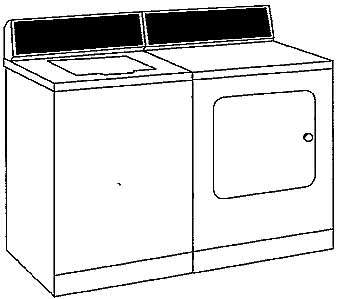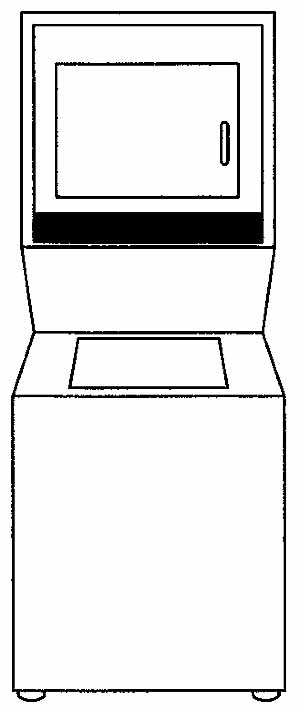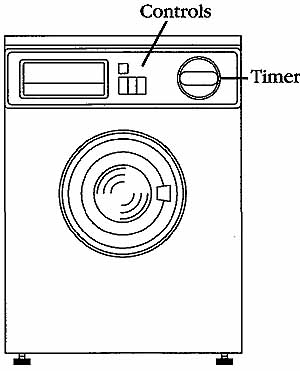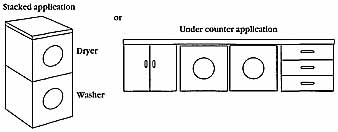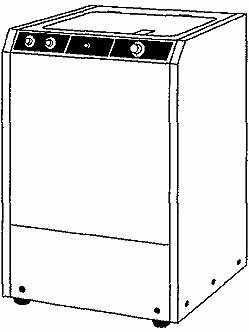Selecting, purchasing, and installing Laundry equipment
| HOME | Troubleshooting | DIY Tips |
|
Today’s laundry equipment, along with changes in fibers and fashions, usually have eliminated the need for hand laundering, clothesline drying, and routine ironing. There are features for pre-programming the appliance for any type of laundry load. These all give excellent results. From diapers and jeans, to delicate silks and knits, today’s laundry system is equipped for all fabric needs. The typical laundry pair, a standard washer and dryer, will stand side-by-side in 4½ to 5 feet of wall space, depending on the brand and model ( Fig. __12). Some questions to consider when choosing laundry appliances are: • Is there enough space available for laundry appliances? • What control location will be best for the principal user? Some models offer front or rear controls. • What capacity will best satisfy family needs? • Will built-in dispensers for bleach and fabric softener increase washer’s utility? • Will the dryer need to be vented outside? • Which is preferred (gas or electric) for drying clothes? • How many types of washing cycles are needed? • How many types of drying cycles are needed? Automatic washers Basically, all automatic washers will wash the clothes in the same manner, but there are some key differences in design and special features from model to model, and manufacturer to manufacturer. Top-loading automatic washers Top-loading models vary in width from about 24 to 30 inches ( Fig. __12). They are available in a variety of load capacities. Standard capacity washers are built for the average 2 to 4 person household. However, a large capacity model reduces the number of loads washed, saving time. Some models offer front panel controls, and many models have dispensers. Listed below are some advantages and disadvantages of top-loading washers ( Fig. __13): Advantages • Provide a convenient, at-home way to do laundry. • Models installed in a small space, only 24 inches wide, are available. • Models with front controls can be reached and operated easily from a seated position. • Provide a variety of designs and control positions to meet varying user needs. Disadvantages • Models with rear console controls are virtually impossible to operate from a seated position. • Some designs might require special aids to remove loads, set controls, and clean filters from a seated position. • Compact models, with greatest accessibility from a wheelchair, have a smaller load capacity than other designs.
Front-loading automatic washers Front-loading models might have drop-down or side-opening doors (Fig. __14). In these models, the entire wash basket revolves. As these clothes tumble, they are lifted by vanes on the side of the basket. Front loaders use less water than top loaders, but they will not handle very large loads because they must have empty space in the drum to tumble clothes. Listed below are some advantages and disadvantages of front-loading washers (Fig. __15): Advantages • Front controls can be reached and operated easily from a seated position. • Front opening makes loading and unloading easier for users with limitations. Disadvantages • Drop-down door might create wheelchair barrier. • Door opening might be too low for some wheelchair users, or those who cannot stoop or bend.
Compact automatic washers Compact, “apartment-sized”, washers range from 24” to 27” wide to fit spatial needs. They are available in two forms: built-in, or on casters, so they can be rolled to the kitchen sink for use. Matching dryers can be installed next to the washer, stacked on a special rack, wall hung, or purchased as a one-piece unit with the washer (Fig. __16).
Automatic dryers Automatic dryers perform in the same tumbling manner as front-loading automatic washing machines. But, there are some key differences in design and special features from model to model, and manufacturer to manufacturer. Dryers are available in a choice of electric or gas. They vary in a variety of load capacities. Some models offer front (or rear) controls, and side-opening (or drop-down) doors. For best efficiency, an electric dryer should have a minimum rating of 4400 watts. Gas dryers require a 120-volt outlet for such features as the motor, lights, and ignition. The gas heater should have a rating of at least 20,000 BTU/hour for top performance. Dryers should be installed in an area that permits proper venting. Compact, “apartment-sized”, dryers range from 24” to 27” wide, so as to fit spatial needs. They are available in two forms: built-in or separate. Compact dryers are electric (either 120-, or 240-volt). The 120-volt dryer takes at least twice as long to dry as the 240-volt model does. While venting is recommended for all dryers, some 120-volt models can be used without venting, if they are not in an enclosed space. The 240-volt dryers must be vented to prevent damage from moisture build-up in the home. Compact dryers can be installed next to the washer, stacked on a special rack, wall hung, or purchased as a one-piece unit with the washer. Listed below are some advantages and disadvantages of automatic dryers: Advantages • Eliminate the difficulties inherent in line drying. • Give modern fabrics proper care, practically eliminating the ironing chore. • Designs available to meet the needs of most disabled persons. Disadvantages • Models with rear controls are virtually impossible to operate from a seated position. • Dryer door might be too low without a raised installation. • As with washers, compact dryers have a smaller load capacity than other designs. Checklist for washers and dryers Before going to the store for selecting and purchasing laundry equipment, read and fill out this section on washers and dryers. Check all that apply: Washer selection chart • What size is wanted?
• Style
• Cycle selections
• Options
• Color__________ Dryer selection chart • Which type is preferred?
• What size is needed?
• Cycle selections
• Other options
• Color: ___ • Tub (stainless or porcelain) • Price range: $_________________ • Warranty and service information: _________
Prev: Dishwashers |
